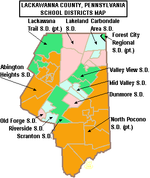White Oak Run (Lackawanna River tributary)
White Oak Run (also known as White Oak Run No. 1) is a tributary of the Lackawanna River in Lackawanna County, Pennsylvania, in the United States. It is approximately 3.4 miles (5.5 km) long and flows through Jefferson Township and Archbald. The watershed of the stream has an area of 5.11 square miles (13.2 km2). The stream is impacted by various types of debris, localized iron hydroxide deposits, stormwater, and combined sewer overflows. However, its middle and upper reaches are largely undisturbed. The White Oak Ravines are in the stream's watershed. A number of mine openings historically existed along White Oak Run. A bridge was also constructed across the stream in 1908. White Oak Run is designated as a Coldwater Fishery and a Migratory Fishery. It has a stable riparian buffer in many of its reaches. Plants in the buffer include hemlocks and rhododendrons.
Excerpt from the Wikipedia article White Oak Run (Lackawanna River tributary) (License: CC BY-SA 3.0, Authors).White Oak Run (Lackawanna River tributary)
North Main Street,
Geographical coordinates (GPS) Address Nearby Places Show on map
Geographical coordinates (GPS)
| Latitude | Longitude |
|---|---|
| N 41.49705 ° | E -75.54035 ° |
Address
North Main Street 441
18403
Pennsylvania, United States
Open on Google Maps




